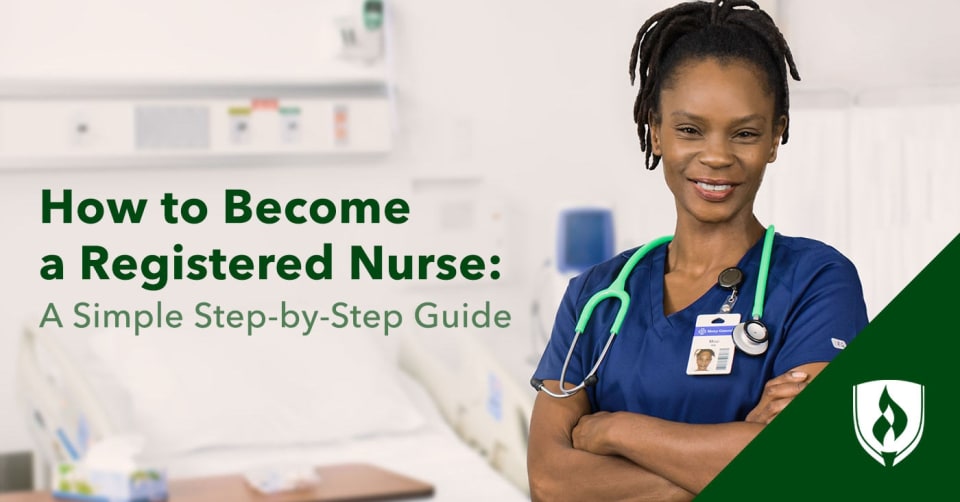
Becoming a nurse may seem daunting when you have other things on your plate. Between working, family commitments and the demands of other life priorities, it might seem hard to finally make the decision to go back to school and become a registered nurse (RN).
That’s undoubtedly a big commitment that comes with a lot of unknowns that may be holding you back. Fortunately, those unknowns are something we can help you with! In this article, we’ll break the process of becoming a registered nurse down into four steps. While each of these steps is certainly significant on their own, you can move forward with confidence as you’ll know the path ahead.
Read on for a simple, step-by-step guide to becoming a registered nurse.
Get Your Nursing School Questions Answered at a Nursing Information Session
4 Simple steps to become a registered nurse
The four steps to becoming a registered nurse are:
- Picking which kind of RN-qualifying nursing degree you want to end up with—an Associate’s Degree in Nursing or a Bachelor of Science in Nursing
- Gaining admission into a nursing program
- Completing nursing coursework and clinicals
- Passing the NCLEX-RN® exam and meeting state licensure requirements
Of course, a bullet point doesn’t do any of these steps justice. We’ll go into much further detail for each below.
1. Research nursing degree options
Before committing to a nursing school, you will want to think about your overall career goals. Since there are two major education paths you can take to become an RN, you’ll need to decide what the best fit is for your schedule and long-term plans.
For those who would prefer to get out into the working world as soon as possible, there’s the Associate’s Degree in Nursing (ADN) route. At Rasmussen University, you can earn an ADN in as few as 21 months.1
However, while this route may seem like an appealing option right now, you may eventually have to go back to school to acquire a Bachelor of Science in Nursing (BSN) if you are planning on working in some hospitals or specialized nursing roles.
While that may seem like a deterrent, some employers may help pay for their ADN nurses to become baccalaureate qualified. Working ADN-RNs have the opportunity to pursue their Bachelor’s degree via a fully online RN to BSN program. The RN to BSN program at Rasmussen University can be completed in as few as 12-18 months.1
The other option for becoming a registered nurse is to complete a four-year Bachelor’s degree program. RNs who hold their BSN credential are qualified for more jobs than nurses with ADNs, including jobs in research, consulting or administrative positions.
In the end, both degrees can lead to a career as an RN—your decision simply depends on what’s best for you based on how much time you want to spend in school and what your personal career goals are. It’s important to remember that nursing is a profession with a wide range of opportunities, so you always have the option of going back to school to advance your career.
2. Enroll in nursing school
Once you’ve decided which degree path you’d like to pursue, it’s time to find a nursing school that aligns with your goals and enroll in a nursing program. We’ve covered how to get into nursing school before, but here’s a brief summary.
After graduating high school, you’ll need to research different nursing programs and then complete an application—typically requiring you to round up some letters of recommendation, write the requisite essays and more. You’ll also likely need to take the Test of Essential Academic Skills (TEAS) exam and prepare for your entrance interview.
It may sound like a lot is required of you right from the get-go, but when you break each step down and tackle it one piece at a time, you’ll start to see your path toward nursing success take shape. The time and effort put into each phase of your process are important factors that can help you get into the school you’ve set your sights on.
3. Complete nursing coursework and clinicals
After you’ve been accepted into nursing school, it may seem like all of the hard work is behind you. But the next stretch of your life will be spent building and strengthening the foundational knowledge and skills required of successful nurses. You can expect to encounter coursework relating to chemistry, biology, anatomy, nutrition and more.
You will also be expected to complete a series of nursing clinicals to help gain hands-on experience and witness what it’s really like to work as an RN. Clinicals provide students with an opportunity to apply what they’ve learned in a real-life healthcare setting, serving as a critical capstone to your education as you learn how to gain your footing in the world of nursing.
4. Pass the NCLEX-RN exam and meet licensure requirements
Once you’ve come this far, you’re almost done on your journey to becoming a nurse. Things will start looking up as you cross the finish line you’ve been chasing after, degree in hand. The only thing separating you from a rewarding career as an RN once you’ve walked across that graduation stage is passing the NCLEX-RN and ensuring you meet all state licensure requirements.
The NCLEX (National Council Licensure Examination) is a required exam for any prospective nurse. With either an ADN or BSN, you would be qualified to sit for the NCLEX-RN. No matter the state you plan to work in, passing the NCLEX-RN is a required step for obtaining state licensure.
The NCLEX-RN contains 75-145 questions that gauge your knowledge of all areas of nursing—and as you might expect, critical thinking and memorization will be key to your success. Expect to spend some time preparing and prepping for this exam, as it’s one of the more important tests you’ll take. Don’t panic, though—you will learn everything you need to in your degree program. Once you’ve passed the NCLEX-RN, you’ve cleared the biggest hurdles. That said, in some states there may be additional administrative requirements for earning licensure, like completing a criminal background check.
After obtaining licensure, you’ll be ready to find employment as a registered nurse—so get your resume ready and prepare to help fill the nursing shortage.
Which nursing path will you choose?
Now that you know the various steps you’ll need to take to become an RN, it’s time to decide how you’ll get there. Whether you’re hoping to get into your scrubs faster by earning an ADN or you’re ready to put in the extra time now to ensure some career advancement later with a BSN, time is of the essence.
With that in mind, you’ll want to jump right into the research phase of your journey toward nursing school. Once you pinpoint the specific nursing degree you want to pursue, you’re that much closer to finding the right college. Gain the insight you need about earning your nursing degree and dig into the host of ways Rasmussen University can help you achieve your goal by checking out our article “10 Facts You Didn’t Know About the Rasmussen University Nursing Program.”
Related Articles:
- ADN vs ASN: Is There Any Difference Between These Nursing Degrees?
- What Can You Do with an Associate's Degree in Nursing?
- Florida Nursing: 3 Great Reasons for Becoming a Nurse in the Sunshine State
- Caring for Your Country: A Closer Look at the Role of a Military Nurse
1Completion time is dependent on the number of transfer credits accepted and the number of courses completed each term.
EDITOR’S NOTE: This article was originally published in April 2015. It has since been updated to include information relevant to 2021.
NCLEX-RN is a registered trademark of the National Council of State Boards of Nursing, Inc.




